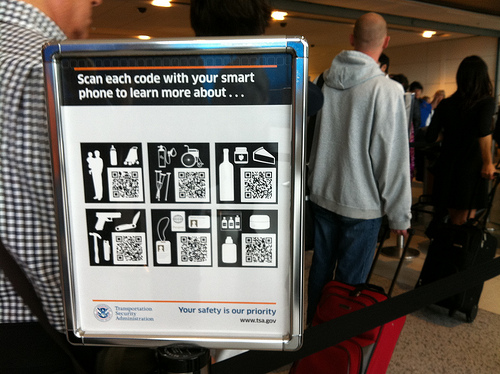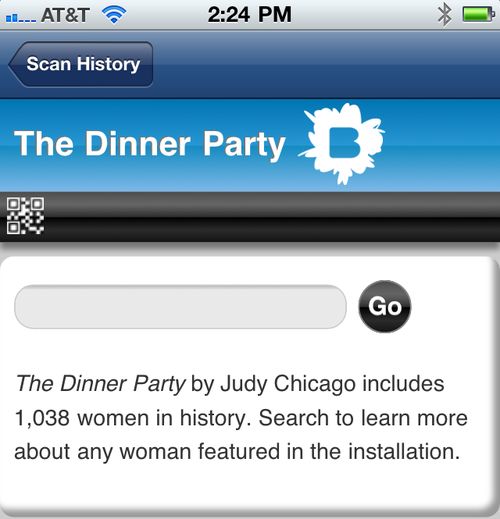QR Code Conundrum
I’ve long been a critic of QR Codes. When I look around, I see low adoption rates, technical hurdles for end users and some really annoying uses in the marketing sector—who wants that?

Do we really need QR codes on TSA signs? Is this sign not clear enough without them? What's even more frustrating is the codes don't even send you to a site that's optimized for mobile.
As critical as I am, there have been some really good uses in museums and I think we are starting to see a tide change in New York City. For starters, the city is using them on all the building permits, so you can learn more as you pass construction sites. There are plans in the works for QR codes on all the restaurant inspections plaques. If there’s one thing that would motivate people to jump the technical hurdles of installing a QR reader, this would be it—the notion that we could see the actual violations that led to a restaurant’s letter grade makes QR truly useful for those of us who obsess about where we eat.
When looking at a possible implementation at the Brooklyn Museum, there are considerations to think about—we’ve got a community-minded mission that takes accessibility very seriously and we are aware that a very large portion of our visitors don’t have the smartphones required to use the codes. That said, we want to start looking at what this equation means for us and, as a result, we’ve just installed QR codes in the Museum as an experiment to see how visitors respond. We are evaluating several different types of uses.

To increase visibility, a code is printed on the back of our entrance tags. Scanning it takes you to a page that describes what scanning codes throughout the building will get you.
In The Dinner Party and Luce Visible Storage, you can use the QR to jump to mobile versions of our collections database. Each of these galleries provides limited information on the walls and, instead, we ask visitors to use kiosks to retrieve information about objects. By installing QR codes, we are providing additional means to view that information via mobile, but no one is left out of the experience—if they don’t have the technology, they can use the computers instead.

Scanning the QR code in the gallery takes you to a search page formatted for mobile devices. If you can't scan the code, signage also gives you the mobile URL. If you don't have a mobile device, you can still use in-gallery kiosks.
We are also testing the idea of QR as an on-demand platform. For the last year, our mobile game, Gallery Tag!, has been integrated into our mobile app, but its use has been quite low. While we have gotten good feedback from visitors who’ve played it, the visibility of the game buried within our mobile presence has made it difficult to find, so we are putting the game behind a QR code to see if it helps make the application more visible within the exhibition space.
Lastly, we’ve created a poetry trail throughout the museum using the poems that Raj Arumugam composed using our collection online. This takes community-generated content from the web and puts it next to the objects in the gallery, showcasing a community voice in the permanent collections. We are interested to see if codes are scanned for individual objects and if visitors are interested in community generated content as another layer in the gallery. The question does remain—can this content be found? QR codes are striking and catch the eye, but with 3000+ objects on view, it will be difficult to find the 30 codes sprinkled throughout the museum that reveal poems. This part of the trial may prove to give us information that is too limited.

QR codes installed near objects in the permanent collection link to poetry.
In the QR code trial, we want to make sure the codes do not create unnecessary confusion or exclusion for visitors and, to this end, we’ve created a mobile palm card to help explain things. While we still expect use to be fairly low, we’ll be looking at metrics and comparing them to other types of mobile use, namely our mobile website and our mobile app—we are curious to see if pickup rate increases as we move to an on-demand system using readily off the shelf technology.

Mobile palm cards explain the various mobile options, including directions on finding and installing QR readers. Cards are located at the visitor desk in the lobby and all the floors along with our maps and audio guide information.
This experiment may change how we develop for mobile in the future, so I’ll report back on our findings in a couple of months. In the meantime, we’d love for you to come try them out and let us know about your experience.

Shelley Bernstein is the former Vice Director of Digital Engagement & Technology at the Brooklyn Museum where she spearheaded digital projects with public participation at their center. In the most recent example—ASK Brooklyn Museum—visitors ask questions using their mobile devices and experts answer in real time. She organized three award-winning projects—Click! A Crowd-Curated Exhibition, Split Second: Indian Paintings, GO: a community-curated open studio project—which enabled the public to participate in the exhibition process.
Shelley was named one of the 40 Under 40 in Crain's New York Business and her work on the Museum's digital strategy has been featured in the New York Times.
In 2016, Shelley joined the staff at the Barnes Foundation as the Deputy Director of Digital Initiatives and Chief Experience Officer.
